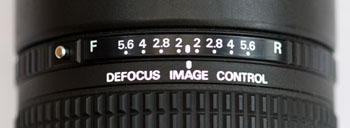 The term Bokeh is used to describe a particular aesthetic and rather subjective quality of out-of-focus areas in an image. The word itself is derived from the Japanese Kanji
The term Bokeh is used to describe a particular aesthetic and rather subjective quality of out-of-focus areas in an image. The word itself is derived from the Japanese Kanji 
 (Romanji pronunciation "boke", English pronunciation "bo-keh") meaning something like "obscure", "hazy" "dizzy" or "fuzzy". The out-of-focus quality to which the description is applied is not simply the unsharp effect arising as a consequence of an area lying outside the depth of field envelope. It is more to do with the way in which a particular lens and diaphragm (or other aperture) combination renders out-of-focus points of light.
(Romanji pronunciation "boke", English pronunciation "bo-keh") meaning something like "obscure", "hazy" "dizzy" or "fuzzy". The out-of-focus quality to which the description is applied is not simply the unsharp effect arising as a consequence of an area lying outside the depth of field envelope. It is more to do with the way in which a particular lens and diaphragm (or other aperture) combination renders out-of-focus points of light.
To put it simply, bokeh is the way in which out-of-focus points of light are rendered. It is not a degree of sharpness. Sharpness refers to a characteristic of an image in the plane of focus. Bokeh is a characteristic of the out-of-focus areas but not a measure of unsharpness. It is to do with the aesthetic nature of the unsharp areas of an image and whether or not they are blurred in an attractive manner. The image of the girl on the left, taken in the Cook Islands, features a large number of out-of-focus highlights in the background. These were produced by points of light filtering through tree foliage.
When a lens is focused at a particular distance, objects in the plane of focus are rendered critically sharp. The so-called plane of focus is spherical rather than planar. The radius of the sphere is equal to the focused distance, so objects which lie at the relevant distance from the lens will all be sharp in an image - ie points of light will be rendered as tiny points of light on the film or sensor.. Objects situated at greater of lesser distances from the lens will be rendered less than critically sharp. In other words they will be slightly blurred - ie rendered as small circles of light on the film or sensor. Bokeh is the aesthetic quality produced by these circles of light and the consequent unsharpness.
With a perfect lens all in-focus points of light are precisely focused as points in the plane of the film or sensor. Out-of-focus points of light are rendered as small circles of light with sharp edges known as circles of confusion or blur circles. However no lens is perfect. Optical and mechanical designs vary considerably, and some lenses feature aberrations which blur points of light and other small bright areas in a more attractive manner than others. When considering bokeh, the most important optical characteristic is spherical aberration.
In a a theoretical lens with no spherical aberration, circles of confusion with sharp edges produced by out-of-focus points of light are evenly illuminated - ie the distribution of light intensity across the circle is uniform. Diffraction may in some instances produce vague but visible rings around otherwise sharp circles, but that is a completely different optical phenomenon. In practice, all lenses feature some degree of spherical aberration, and out-of-focus points of light may be rendered as circles featuring uneven distribution of light intensity. In some cases the light may be most intense at at the centre of the circle, and in other cases it may be less intense. Under-corrected and over-corrected spherical aberration produce different results, so a lens that gives good background bokeh is unlikely to produce good foreground bokeh.
Most people find soft backgrounds attractive in images, so it is desirable to avoid sharp-edged background circles of confusion. The combined effect of many sharp edges can result in an impression of detail or texture being perceived in an out-of-focus background. This is regarded as unattractive or bad bokeh. Soft-edged circles of confusion are produced when the intensity of light within the circles is concentrated towards the centre. A typical circle then fades gradually towards its outer edges and blends easily with other neighbouring circles to produce a soft and attractive feeling.
Nikon's DC (Defocus Control) lenses (105mm f/2 DC and 135mm f/2 DC), which are ideal for portraiture, allow the photographer effectively to shift the depth of field envelope relative to the point of focus. The defocus control changes the spherical aberration characteristics and allows good bokeh to be positioned in the foreground or background as required.

The mechanical design of a diaphragm aperture has at least some bearing upon bokeh by shaping the out-of-focus highlights. Apertures that are far from circular tend to produce poor bokeh. A diaphragm aperture having six blades will produce small hexagonal highlights, and one with nine aperture blades (such as the Nikon 135mm f/2 DC lens) will produce almost circular highlights. Some lenses incorporate curved aperture blades (again like the Nikon DC lenses below left) to achieve out-of-focus highlights as close as possible to circular. Mirror (reflex) lenses have poor bokeh because the centre of the aperture is obstructed by a mirror. Out-of-focus highlights are therefore rendered as unnatural looking doughnuts.
 Bokeh is most apparent when using a fast (large maximum aperture) lens such as f/1.2, f/1.4, f/1.8, f/2 or f/2.8. When the diaphragm aperture is wide open the depth of field is minimized and out-of-focus areas are more extensive and noticeable. This is a situation familiar to portrait photographers who seek to lift the subject out of a background that is intentionally rendered unsharp. When "good bokeh" features in an image, the result can be very attractive and may also enhance the extent to which an in-focus foreground subject stands out.
Bokeh is most apparent when using a fast (large maximum aperture) lens such as f/1.2, f/1.4, f/1.8, f/2 or f/2.8. When the diaphragm aperture is wide open the depth of field is minimized and out-of-focus areas are more extensive and noticeable. This is a situation familiar to portrait photographers who seek to lift the subject out of a background that is intentionally rendered unsharp. When "good bokeh" features in an image, the result can be very attractive and may also enhance the extent to which an in-focus foreground subject stands out.
In summary, Bokeh is a direct consequence of spherical aberration and the circle of confusion, which causes out-of-focus points of light to be rendered as small and hopefully soft near-circular shapes resembling the diaphragm aperture. These bright out-of-focus highlights may have variable intensities and saturations, and may even overlap each other. Portraiture lenses, medium telephoto lenses such as 85mm, 105mm and 135mm optics, often produce attractive bokeh at wide apertures. Those with a larger number of diaphragm blades, giving a near-circular aperture, also seem to work well in this respect.
It is probably worth mentioning that interest in bokeh photography, where bokeh becomes the subject or a key part of the image, is part of a fashionable trend. Not too many years ago some learned photographic institutions frowned at the inclusion or enhancement of such features in high quality portraits and other images.






